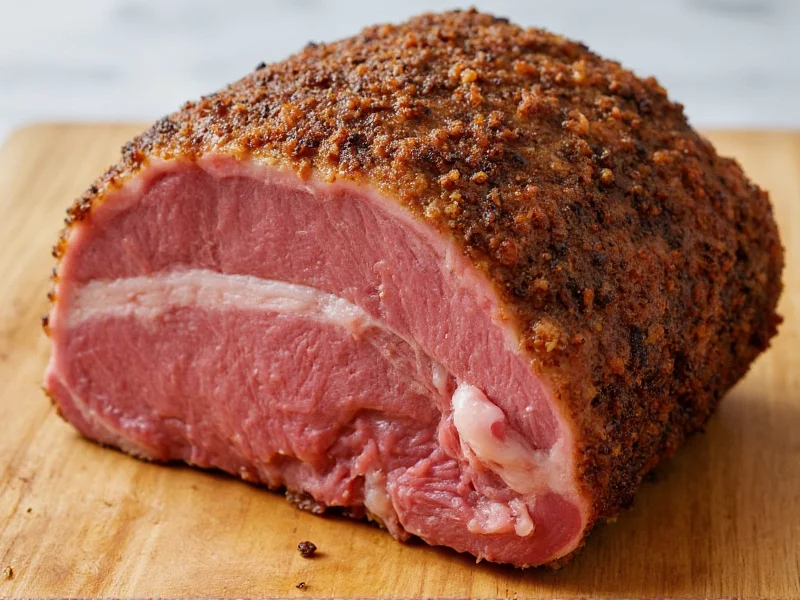The Science Behind Effective Pork Butt Rubs
Creating an exceptional pork butt rub requires understanding how ingredients interact with meat chemistry. Salt draws out moisture initially, then helps reabsorb seasoned liquids back into the muscle fibers. Sugar caramelizes during cooking, forming the coveted bark that seals in juices. Spices like paprika and cumin contain volatile compounds that bind with fat molecules, carrying flavor deep into the meat.
Essential Components of a Balanced Rub
Professional pitmasters categorize rub ingredients into four functional groups:
| Ingredient Category | Primary Function | Common Examples |
|---|---|---|
| Salt Base | Moisture control & protein denaturation | Kosher salt, sea salt, curing salt |
| Sweet Elements | Caramelization & bark formation | Brown sugar, white sugar, maple sugar |
| Peppery Components | Heat & complexity | Black pepper, cayenne, chipotle powder |
| Aromatic Spices | Flavor depth & aroma | Paprika, garlic powder, onion powder |
Classic Pork Butt Rub Recipe
This versatile formula works for both competition-style and backyard barbecue. Yields enough for 8–10 pounds of meat:
- 1½ cups coarse kosher salt
- 1 cup packed brown sugar
- ½ cup freshly ground black pepper
- ½ cup smoked paprika
- 3 tablespoons garlic powder
- 3 tablespoons onion powder
- 2 tablespoons ground cumin
- 1 tablespoon cayenne pepper (optional for heat)
- 1 tablespoon dry mustard
Mix thoroughly in a bowl, breaking up any clumps. Store in an airtight container away from light for up to 6 months. The brown sugar’s molasses content enhances Maillard reactions during smoking, while smoked paprika adds depth without requiring liquid smoke.
Regional Rub Variations
Different barbecue traditions approach pork butt seasoning uniquely:
Carolina Style
Eastern North Carolina emphasizes vinegar-based mops over heavy rubs, but a light dry rub often includes:
- Increased black pepper (up to 60% of spice blend)
- Minimal sugar (only 1–2 tablespoons per cup of rub)
- Addition of celery salt and dry mustard
- Often applied just before cooking with vinegar mop applied during smoking
Texas Influence
While Texas focuses on brisket, many pitmasters adapt their approach for pork:
- Higher salt-to-sugar ratio (2:1)
- Increased black pepper (sometimes coarsely cracked)
- Smoked paprika replaces sweet paprika
- Chili powder instead of cayenne for more complex heat
Application Techniques That Make a Difference
How you apply your pork shoulder seasoning recipe affects results more than most home cooks realize. Follow these professional techniques:
- Dry the surface: Pat the pork butt thoroughly with paper towels before applying rub. Moisture prevents proper adhesion.
- Seasoning salt layer: Sprinkle 1 teaspoon of fine salt per pound and let sit 30 minutes. This creates microscopic channels for deeper penetration.
- Generous application: Use 1 tablespoon of rub per pound of meat, pressing firmly into all crevices.
- Refrigeration time: Minimum 12 hours, ideally 24–48 hours. The salt continues working during this time.
- Pre-cook adjustment: If storing more than 24 hours, scrape off excess rub and reapply a fresh layer before cooking.
Troubleshooting Common Rub Problems
Even experienced pitmasters encounter issues with their best dry rub for pork butt. Here's how to fix them:
Bitter or Burnt Flavor
Cause: Sugar burning due to high cooking temperatures or excessive sugar content.
Solution: Reduce sugar by 25%, use white sugar instead of brown, or lower cooking temperature by 25°F.
Rub Washing Off During Cooking
Cause: Insufficient drying time after application or too much moisture on meat surface.
Solution: Ensure meat surface is completely dry before applying rub, and let seasoned meat sit uncovered in refrigerator for 1–2 hours before cooking.
Uneven Bark Formation
Cause: Inconsistent rub application or temperature fluctuations.
Solution: Apply rub in multiple thin layers rather than one thick coat, and maintain stable smoker temperature within ±15°F.
Advanced Tips from Championship Pitmasters
For those seeking competition-level results with their homemade pork butt rub:
- Toasted spices: Lightly toast whole spices like cumin seeds and black peppercorns before grinding for deeper flavor.
- Salt timing: Apply salt 24 hours before other ingredients to maximize protein modification.
- Acid boost: Add 1 tablespoon of citric acid per cup of rub for brighter flavor without moisture issues.
- Fat infusion: Mix 2 tablespoons of rendered pork fat into the rub for better adhesion and flavor transfer.
Storage and Shelf Life Guidelines
Properly stored dry rub maintains potency for months. Follow these guidelines:
- Use airtight glass or metal containers (plastic can absorb odors)
- Store away from direct light and heat sources
- Maximum shelf life: 6 months for optimal flavor
- Check for clumping or color changes indicating moisture exposure
- Never return unused rub from the meat surface to the original container
Pairing Rubs with Cooking Methods
Different cooking techniques require rub adjustments for best results:
Low and Slow Smoking (225–250°F)
Use standard rub formula. The extended cooking time allows full flavor development without burning.
High-Heat Searing (350–400°F)
Reduce sugar content by 50% to prevent burning. Increase salt proportionally to maintain flavor balance.
Sous Vide Preparation
Apply rub after sous vide cooking during the searing phase. Sugar-based rubs will caramelize perfectly without burning.











 浙公网安备
33010002000092号
浙公网安备
33010002000092号 浙B2-20120091-4
浙B2-20120091-4